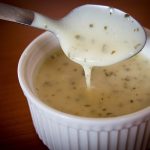
The use of starch in foods has taken many turns especially in dairy processing and the generation of both beverages and desserts. Starches as an ingredient have been important from a functional point of view of imparting mouthfeel and maintaining texture. They have been highly instrumental in helping consumers enjoy a wide variety of dairy products.
Originally, many dairy products such as custards, mousses, puddings and the like relied on a rather unrefined corn starch which along with milk gave a very think, almost glue like consistency to a dairy dessert. The use of corn starch invariably produces a typical consistency and texture associated with the phrase ‘starchy’ which still finds its way into sauces and gravy.
Whilst corn starch has particular mouthfeel properties, modified waxy maize starch produces a generally smoother texture and has largely superseded this starch because it has a better stability and is highly versatile. Maize (corn) starches can impart stability even at low temperatures along with very good temperature and shear resistance. Other starches are available but none perhaps as good in terms of functionality as that from maize.
When it comes to ultra-heat processing as in dairy beverages, most native starches cannot survive the temperature so are rarely entertained in product development. Where desserts are concerned, native starches will shrink or demonstrate a type of retrogradation with the milky liquid seeping away and separating out even in a briefly refrigerated storage product for a couple of weeks. The selection of modified starches means that a product can have both extended shelf-stability with refrigeration, and also have a built-in freeze-thaw stability which allows consumers to benefit from a shelf-life with frozen storage.
New native starches have also been produced and introduced with good functional properties which are based on corn and tapioca. These are specially processed native starches and are suited to most food development applications where starch gels are needed that can withstand a variety of extreme process conditions such as high shear, high heat and freeze-thaw. Improvements in gelatinization and pasting characteristics, solubility and and clarity are possible with differing degrees of modification of these starches too.
Starch Modification
Starch modification has also allowed for improved solubility, and clarity. Modification of starch can lead to viscosity generation or reduction, freeze-thaw stability, better gel strength and appearance with control over syneresis (gel shrinkage). This makes them more versatile for use in pudding processing.
Modified starch is used mainly for texture creation. It is used between 3% and 6% w/w in pudding formulations. Lower levels are needed for creating looser, more fluid structures whereas levels above 6% generate a more firm gelled structure.
All modifed starches are pre-gelatinised. They can then be used in dry instant pudding mixes, and a particular form of pre-gelatinised cross-linked modified starch is subject to cooking, followed by spray drying or drum drying. On contact with cold or ambient temperature water an instant gel is formed. Starch upon proper cooling becomes soluble and loses its birefringence property. The chemically modified starches are described in the United States Code of Federal Regulations, Title 21, Section 172.892
Processing Considerations
In batch pasteurisation following preheating and homogenisation, only moderately cross-linked starches are needed to preserve product integrity. When it comes to UHT processing of any sort, more highly cross-linked starches are needed and the need is greater for direct processing compared to indirect processing. Aseptic UHT processing with high pressure is the most severe condition as far as preserving starch functionality is concerned, since the temperature and shear rate are additive in disrupting starch granules.
Aseptic processing of diary products, such as puddings, is increasingly popular. It requires a brief (3 to 10 seconds) exposure to very high temperatures followed by packing in sterile containers under sterile conditions. While providing long product life, aseptic processing has advantages over traditional heat treatment such as canning.
Loss of viscosity is also associated with the presence of amylases which degrade starch. Their presence is keenly felt when UHT sterilisation has not gone according to plan for ingredients have been used where the amylase is especially thermostable. It is a phenomenon not readily recognisable initially because the starch granules are clearly visible but when the product thins, the granules are no longer seen. This loss of starch granules occurs when heat-stable amylases are present. The amylase is generally derived from notable bacteria and is usually metal dependent. If calcium ions are removed the amylase activity is severely curtailed The phenomenon has been reproduced by the addition of an alpha-amylase from Bacillus stearothermophilus to an unspoiled product. It is estimated that this particular bacteria’s amylase loses about 74% of its activity even with processing at 143 C for 22.2 seconds which implies 26% of the activity is left. The amylase from Xanthomonas campestris is also thermally stable and thus capable of degrading starch if poorly processed xanthan gum is present (Datta and Deeth, 2007).
References
Chandan, R.C., Kilara, A., Shah, N.P. (2015) Dairy Processing and Quality Assurance. Wiley & Sons. 2nd Edt.
Datta, N., Deeth, H.C. (2007) UHT and aseptic Processing of Milk and Milk Products. Edt. Tewari, G. Juneja, V.K. In: Advances in Thermal and Non-thermal Food Preservation. Blackwell Publishing Pp. 63-90
Tewari, G. Juneja, V.K. (2007) Advances in Thermal and Non-Thermal Food Preservation. Blackwell Publishing.


Leave a Reply